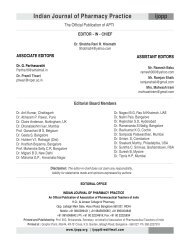Oct-Dec, 2011 - Indian Journal of Pharmacy Practice
Oct-Dec, 2011 - Indian Journal of Pharmacy Practice
Oct-Dec, 2011 - Indian Journal of Pharmacy Practice
- No tags were found...
Create successful ePaper yourself
Turn your PDF publications into a flip-book with our unique Google optimized e-Paper software.
<strong>Indian</strong> <strong>Journal</strong> <strong>of</strong> <strong>Pharmacy</strong> <strong>Practice</strong>Association <strong>of</strong> Pharmaceutical Teachers <strong>of</strong> IndiaEvaluation <strong>of</strong> the Impact <strong>of</strong> a Therapeutic Management and Effect <strong>of</strong> PharmacistIntervention on Children with Asthma2 1 1 3Ramesh A , Satyanarayana V* , Rajani M , Rajani V1Department <strong>of</strong> <strong>Pharmacy</strong> <strong>Practice</strong>, Sri Venkateshwara College <strong>of</strong> <strong>Pharmacy</strong>, Hyderabad, A.P, India.2Vishnu Institute <strong>of</strong> Pharmaceutical Education and Research, Narsapur, Andhra Pradesh3Vel's College <strong>of</strong> <strong>Pharmacy</strong>, Chennai, T.NA B S T R A C TSubmitted: 16/10/<strong>2011</strong>Accepted: 9/11/<strong>2011</strong>Asthma is an inflammatory airways disease caused by a complex interaction between host susceptibility (genetics) and diverse environmental1factors. It is apparent from ongoing research that no single susceptibility gene confers a major risk for this disease . In a large number <strong>of</strong> cases, itcan be well managed. In addition to accurate diagnosis, appropriate therapy and control <strong>of</strong> environment factors, a good educational program isrequired which has not yet received due attention. Prompted by the fact that a large number <strong>of</strong> asthmatic children and their parents lack sufficient2knowledge about asthma . The aim <strong>of</strong> the present study was carried out to evaluate the impact <strong>of</strong> a therapeutic management and effect <strong>of</strong>ststpharmacist intervention on children with asthma. The study was conducted for a period <strong>of</strong> 6 months from 1 November 2010 to 31 April <strong>2011</strong>.This study was conducted in the Gandhi general hospital, Hyderabad, Pediatric unit has five units distributed into two wards, each unitconsisting <strong>of</strong> 30 beds total <strong>of</strong> 150 beds, providing specialized health care service to all strata <strong>of</strong> people in A.P,India. This was a prospective andobservational study and was approved by IRB. A total <strong>of</strong> 100 patients were enrolled in the present study during the study period. Out <strong>of</strong> the 60(60%) were males and 40 (40%) were female patients. Total distribution <strong>of</strong> patients with respect to age group showed that highest number <strong>of</strong>patients was found in the age group <strong>of</strong> 1-3 years (40%) and least was found between 11-12 years age group (2%). During pre-intervention periodnumber <strong>of</strong> irrational prescribing reported was 161, but after intervention it was significantly reduced to 93.Keywords: Children, Asthma, Intervention, Pharmacotherapy.INTRODUCTIONAsthma is a chronic inflammatory disorder <strong>of</strong> the airways.Chronically inflamed airways are hyperresponsive, theybecome obstructed and limit the airflow (bybronchoconstriction, mucus plugs, and increasedinflammation) when airways are exposed to various risk3factors . With approximately 300 million persons currentlysuffering from asthma worldwide, this condition is one <strong>of</strong> the4, 5most common chronic diseases, especially in childhood .Asthma can be effectively treated and most patients canachieve good control <strong>of</strong> their disease. When asthma is undercontrol children can: avoid troublesome symptoms night andday, use little or no reliever medication, have productive,physically active lives, have normal lung function and avoidserious attacks. Asthma causes recurring episodes <strong>of</strong>Address for Correspondence:Satyanarayana V, Department <strong>of</strong> <strong>Pharmacy</strong> <strong>Practice</strong>, Sri VenkateshwaraCollege Of <strong>Pharmacy</strong>, Hyderabad, A.P, India.E-mail: rajanisvcp@gmail.comwheezing, breathlessness, chest tightness and coughing,particularly at night or in the early morning. Asthma attacks(or exacerbations) are episodic, but airway inflammation is6chronically present .Asthma is a major cause <strong>of</strong> chronic morbidity and mortalitythroughout the world and there is evidence that its prevalencehas increased considerably over the past 20 years, especiallyin children. The prevalence <strong>of</strong> asthma symptoms in childrenvaries from 1 to more than 30 % in different populations and isincreasing in most countries, especially among young7children . Mean worldwide current wheeze prevalence ratesin the last 12 months range from 11.6% in 6-7 years agechildren to 13.7% in 13-14 years olds, according to Phase III8<strong>of</strong> the international study <strong>of</strong> asthma and allergies in children .In a large number <strong>of</strong> cases, it can be well managed. In additionto accurate <strong>of</strong> environmental factors, a good educationalprogram is required, which has not yet received due attention.Prompted by the fact that a large number <strong>of</strong> asthmatic children2and their parents lack sufficient knowledge about asthma .<strong>Indian</strong> <strong>Journal</strong> <strong>of</strong> <strong>Pharmacy</strong> <strong>Practice</strong> Volume 4 Issue 4 <strong>Oct</strong> - <strong>Dec</strong>, <strong>2011</strong> 39
















